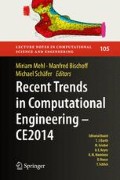Abstract
The focus of the present contribution is on the numerical modelling of hydraulic fracture in fluid-saturated heterogeneous materials, which can be carried out on a macroscopic scale using extended continuum porous media theories. This accounts for the crack nucleation and propagation, deformation of the solid matrix and change in the flow of the interstitial fluid. In particular, fluid-saturated porous materials basically represent volumetrically interacting solid-fluid aggregates, which are modelled using the Theory of Porous Media. The hydraulic- or tension-induced fracture occurs in the solid matrix and is simulated using a diffusive phase-field modelling approach. This way of fracture treatment adds a partial differential equation of the phase-field evolution to the coupled solid-fluid problem, which requires special stabilisation techniques in the numerical calculation. A numerical example is also presented to demonstrate this way of fracture handling.
Access this chapter
Tax calculation will be finalised at checkout
Purchases are for personal use only
Notes
- 1.
For a scalar value a, the Heaviside step function \(H(a) =\{\, 0\,\,\,\mbox{ if}\,\,\,a < 0,\,\,\mbox{ and}\,\,\,1\,\,\,\mbox{ if}\,a \geq 0\}\).
- 2.
A software for FE solutions of partial differential equations, see www.pdesolutions.com.
References
Alber, H., Markert, B.: Second order asymptotics for the propagation speed of interfaces in the allen-cahn phase field model for elastic solids. PAMM 12, 31–34 (2012)
Allen, S., Cahn, J.: A microscopic theory for antiphase boundary motion and its application to antiphase domain coarsening. Acta. Metall. 27, 1085–1095 (1979)
de Boer, R.: Theory of Porous Media. Springer, Berlin (2000)
de Borst, R., Réthoré, J., Abellan, M.: A two-scale approach for fluid flow in fracturing porous media. In: Bicanic, N., de Borst, R., Mang, H., Meschke, G. (eds.) Computational Modelling of Concrete Structures, pp. 451–460. Taylor and Francis, London (2010)
Borden, M.J., Verhoosel, C.V., Scott, M.A., Hughes, T.J.R., Landis, C.M.: A phase-field description of dynamic brittle fracture. Comput. Method. Appl. Mech. 217–220, 77–95 (2012)
Bourdin, B., Francfort, G., Marigo, J.: The variational approach to fracture. J. Elast. 91, 5–148 (2008)
Detournay, E., Cheng, A.H.: Plane strain analysis of a stationary hydraulic fracture in a poroelastic medium. Int. J. Solids Struct. 27, 1645–1662 (1991)
Ehlers, W.: Foundations of multiphasic and porous materials. In: Ehlers, W., Bluhm, J. (eds.) Porous Media: Theory, Experiments and Numerical Applications, pp. 3–86. Springer, Berlin (2002)
Ehlers, W.: Challenges of porous media models in geo- and biomechanical engineering including electro-chemically active polymers and gels. Int. J. Adv. Eng. Sci. Appl. Math. 1, 1–24 (2009)
Francfort, G., Marigo, J.J.: Revisiting brittle fracture as an energy minimization problem. J. Mech. Phys. Solids. 46, 1319–1342 (1998)
Griffith, A.A.: The phenomena of rupture and flow in solids. Philos. Trans. R. Soc. Lond. A 221, 163–198 (1921)
Heider, Y., Markert, B., Ehlers, W.: Dynamic wave propagation in infinite saturated porous media half spaces. Comput. Mech. 49, 319–336 (2012)
Heider, Y., Avci, O., Markert, B., Ehlers, W.: The dynamic response of fluid-saturated porous materials with application to seismically induced soil liquefaction. Soil Dyn. Earthq. Eng. 63, 120–137 (2014)
Irwin, G.R.: Analysis of stresses and strains near the end of a crack traversing a plate. J. Appl. Mech. 24, 361–364 (1957)
Kuhn, C., Müller, R.: A continuum phase field model for fracture. Eng. Fract. Mech. 77, 3625–3634 (2010)
Li, L., Tang, C., Li, G., Wang, S., Liang, Z., Zhang, Y.: Numerical simulation of 3d hydraulic fracturing based on an improved flow-stress-damage model and a parallel fem technique. Rock Mech. Rock Eng. 45, 801–818 (2012)
Markert, B.: A constitutive approach to 3-d nonlinear fluid flow through finite deformable porous continua. Transp. Porous Med. 70, 427–450 (2007)
Markert, B., Heider, Y.: Diffusive porous media fracture. (2015, submitted)
Markert, B., Heider, Y., Ehlers, W.: Comparison of monolithic and splitting solution schemes for dynamic porous media problem. Int. J. Numer. Meth. Eng. 82, 1341–1383 (2010)
Miehe, C., Hofacker, M., Welschinger, F.: A phase field model for rate-independent crack propagation: Robust algorithmic implementation based on operator splits. Comput. Method. Appl. Mech. 199, 2765–2778 (2010)
Mikelic, A., Wheeler, M.F., Wick, T.: A phase-field method for propagating fluid-filled fractures coupled to a surrounding porous medium. In: ICES REPORT 14-08, The Institute for Computational Engineering and Sciences, The University of Texas at Austin (2014)
Moes, N., Belytschko, T.: Extended finite element method for cohesive crack growth. Eng. Fract. Mech. 69, 813–833 (2002)
Remmers, J., de Borst, R., Needleman, A.: A cohesive segments method for the simulation of crack growth. Comput. Mech. 31, 69–77 (2003)
Schlüter, A., Willenbücher, A., Kuhn, C., Müller, R.: Phase field approximation of dynamic brittle fracture. Comput. Mech. 54, 1141–1161 (2014)
Secchi, S., Simoni, L., Schrefler, B.A.: Mesh adaptation and transfer schemes for discrete fracture propagation in porous materials. Int. J. Numer. Anal. Methods 31, 331–345 (2007)
Secchi, S., Simoni, L., Schrefler, B.A.: Hydraulic fracturing and its peculiarities. Asia Pac. J. Comput. Eng. (2014). doi:10.1186/2196–1166–1–8
Zienkiewicz, O.C., Taylor, R.L.: The Finite Element Method. The Basis, vol. 1, 5th edn. Butterworth Heinemann, Oxford (2000)
Author information
Authors and Affiliations
Corresponding author
Editor information
Editors and Affiliations
Rights and permissions
Copyright information
© 2015 Springer International Publishing Switzerland
About this chapter
Cite this chapter
Markert, B., Heider, Y. (2015). Coupled Multi-Field Continuum Methods for Porous Media Fracture. In: Mehl, M., Bischoff, M., Schäfer, M. (eds) Recent Trends in Computational Engineering - CE2014. Lecture Notes in Computational Science and Engineering, vol 105. Springer, Cham. https://doi.org/10.1007/978-3-319-22997-3_10
Download citation
DOI: https://doi.org/10.1007/978-3-319-22997-3_10
Publisher Name: Springer, Cham
Print ISBN: 978-3-319-22996-6
Online ISBN: 978-3-319-22997-3
eBook Packages: Mathematics and StatisticsMathematics and Statistics (R0)

